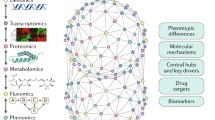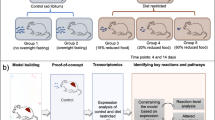Abstract
In recent years, the techniques in molecular biology have been dramatically advanced, and consequently the landscape of metabolism research has undergone a remarkable change. One of the emerging pictures as the fruits of these advancements is one depicting the regulation of systemic metabolism through inter-organ networks involving multiple tissues, either via humoral factors, which are secreted from one tissue and conveyed to their remote target tissues, or through neuronal networks which are integrated by the central nervous system. In addition, the progress in high-throughput research tools enabled detailed characterization and deeper understanding of the nature of human genome, which has attracted much attention to the importance of various non-coding RNAs species. These non-coding RNAs are often co-expressed and co-regulated with adjacent protein coding genes, adding higher levels of complexities by them functioning together as a system and often influencing biologically important pathways in a cooperative manner. Here in this review several examples of these regulatory network systems are presented, illustrating the significance of them in systemic metabolism, with a possible future research direction also being proposed.




Similar content being viewed by others
References
Kershaw EE, Flier JS. Adipose tissue as an endocrine organ. J Clin Endocrinol Metab. 2004;89:2548–56. https://doi.org/10.1210/jc.2004-0395.
Ouchi N, Parker JL, Lugus JJ, Walsh K. Adipokines in inflammation and metabolic disease. Nat Rev Immunol. 2011;11:85–97.
Xu H, et al. Chronic inflammation in fat plays a crucial role in the development of obesity-related insulin resistance. J Clin Invest. 2003;112:1821–30. https://doi.org/10.1172/jci200319451.
Weisberg SP, et al. Obesity is associated with macrophage accumulation in adipose tissue. J Clin Invest. 2003;112:1796–808. https://doi.org/10.1172/jci200319246.
Priest C, Tontonoz P. Inter-organ cross-talk in metabolic syndrome. Nat Metab. 2019;1:1177–88. https://doi.org/10.1038/s42255-019-0145-5.
Kadowaki T, et al. Adiponectin and adiponectin receptors in insulin resistance, diabetes, and the metabolic syndrome. J Clin Invest. 2006;116:1784–92. https://doi.org/10.1172/jci29126.
Yamauchi T, et al. Adiponectin stimulates glucose utilization and fatty-acid oxidation by activating AMP-activated protein kinase. Nat Med. 2002;8:1288–95.
Kubota N, et al. Adiponectin stimulates AMP-activated protein kinase in the hypothalamus and increases food intake. Cell Metab. 2007;6:55–68.
Yamauchi T, et al. Targeted disruption of AdipoR1 and AdipoR2 causes abrogation of adiponectin binding and metabolic actions. Nat Med. 2007;13:332–9.
Holland WL, et al. Receptor-mediated activation of ceramidase activity initiates the pleiotropic actions of adiponectin. Nat Med. 2011;17:55–63.
Awazawa M, et al. Adiponectin suppresses hepatic SREBP1c expression in an AdipoR1/LKB1/AMPK dependent pathway. Biochem Biophys Res Commun. 2009;382:51–6.
Shklyaev S, et al. Sustained peripheral expression of transgene adiponectin offsets the development of diet-induced obesity in rats. PNAS. 2003;100:14217–22. https://doi.org/10.1073/pnas.2333912100.
Xu A, et al. The fat-derived hormone adiponectin alleviates alcoholic and nonalcoholic fatty liver diseases in mice. J Clin Invest. 2003;112:91–100.
Taniguchi CM, Emanuelli B, Kahn CR. Critical nodes in signalling pathways: insights into insulin action. Nat Rev Mol Cell Biol. 2006;7:85–96.
Shimomura I, et al. Decreased IRS-2 and Increased SREBP-1c lead to mixed insulin resistance and sensitivity in livers of lipodystrophic and ob/ob Mice. Mol Cell. 2000;6:77–86.
Awazawa M, et al. Adiponectin enhances insulin sensitivity by increasing hepatic IRS-2 expression via a macrophage-derived IL-6-dependent pathway. Cell Metab. 2011;13:401–12.
Xing Z, et al. IL-6 is an antiinflammatory cytokine required for controlling local or systemic acute inflammatory responses. J Clin Investig. 1998;101:311–20.
Pradhan AD, Manson JE, Rifai N, Buring JE, Ridker PM. C-Reactive protein, Interleukin 6, and risk of developing Type 2 diabetes mellitus. JAMA. 2001;286:327–34. https://doi.org/10.1001/jama.286.3.327.
Pedersen BK, Febbraio MA. Muscle as an endocrine organ: focus on muscle-derived Interleukin-6. Physiol Rev. 2008;88:1379–406. https://doi.org/10.1152/physrev.90100.2007.
Febbraio MA, Hiscock N, Sacchetti M, Fischer CP, Pedersen BK. Interleukin-6 Is a novel factor mediating glucose homeostasis during skeletal muscle contraction. Diabetes. 2004;53:1643–8. https://doi.org/10.2337/diabetes.53.7.1643.
Consortium EP, et al. An integrated encyclopedia of DNA elements in the human genome. Nature. 2012;489:57–74. https://doi.org/10.1038/nature11247.
Esteller M. Non-coding RNAs in human disease. Nat Rev Genet. 2011;12:861–74. https://doi.org/10.1038/nrg3074.
Davis BN, Hata A. Regulation of MicroRNA biogenesis: a miRiad of mechanisms. Cell Commun Signal. 2009;7:18. https://doi.org/10.1186/1478-811X-7-18.
Gromak N. Intronic microRNAs: a crossroad in gene regulation. Biochem Soc Trans. 2012;40:759–61. https://doi.org/10.1042/BST20120023.
Mikkola ML, et al. Ectodysplasin, a protein required for epithelial morphogenesis, is a novel TNF homologue and promotes cell-matrix adhesion. Mech Dev. 1999;88:133–46.
Mikkola ML. Molecular aspects of hypohidrotic ectodermal dysplasia. Am J Med Genet A. 2009;149A:2031–6. https://doi.org/10.1002/ajmg.a.32855.
Lindfors PH, Voutilainen M, Mikkola ML. Ectodysplasin/NF-kappaB signaling in embryonic mammary gland development. J Mammary Gland Biol Neoplasia. 2013;18:165–9. https://doi.org/10.1007/s10911-013-9277-5.
Copps KD, White MF. Regulation of insulin sensitivity by serine/threonine phosphorylation of insulin receptor substrate proteins IRS1 and IRS2. Diabetologia. 2012;55:2565–82. https://doi.org/10.1007/s00125-012-2644-8.
Ozsolak F, et al. Comprehensive polyadenylation site maps in yeast and human reveal pervasive alternative polyadenylation. Cell. 2010;143:1018–29. https://doi.org/10.1016/j.cell.2010.11.020.
Author information
Authors and Affiliations
Corresponding author
Ethics declarations
Conflict of interest
The author declares that he has no conflict of interest.
Human and animal rights statement
This article does not contain any studies with human or animal subjects performed by any of the authors.
Additional information
Publisher's Note
Springer Nature remains neutral with regard to jurisdictional claims in published maps and institutional affiliations.
About this article
Cite this article
Awazawa, M. Exploring regulatory network of metabolism through liver research. Diabetol Int 12, 343–348 (2021). https://doi.org/10.1007/s13340-021-00536-z
Received:
Accepted:
Published:
Issue Date:
DOI: https://doi.org/10.1007/s13340-021-00536-z




